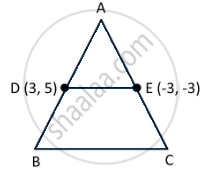Advertisements
Advertisements
Question
Statement A (Assertion): If the coordinates of the mid-points of the sides AB and AC of ∆ABC are D(3, 5) and E(–3, –3) respectively, then BC = 20 units.
Statement R (Reason): The line joining the mid-points of two sides of a triangle is parallel to the third side and equal to half of it.
Options
Both assertion (A) and reason (R) are true and reason (R) is the correct explanation of assertion (A).
Both assertion (A) and reason (R) are true and reason (R) is not the correct explanation of assertion (A).
Assertion (A) is true but reason(R) is false.
Assertion (A) is false but reason(R) is true.
Solution
Both assertion (A) and reason (R) are true and reason (R) is the correct explanation of assertion (A).
Explanation:
Statement A (Assertion): If the coordinates of the mid-points of the sides AB and AC of ∆ABC are D(3, 5) and E(–3, –3) respectively, then BC = 20 units.

We need to use the theorem in Reasoning
The line joining the mid-points of two sides of a triangle is parallel to the third side and equal to half of it.
DE = `1/2` BC
2DE = BC
BC = 2DE
BC = `2 xx sqrt((-3 - 3)^2 + (-3 - 5)^2)`
BC = `2 xx sqrt((-6)^2 + (-8)^2)`
BC = `2 xx sqrt(6^2 + 8^2)`
BC = `2 xx sqrt(36 + 64)`
BC = `2 xx sqrt(100)`
BC = 2 × 10
BC = 20 cm
Thus, Assertion is true.
Statement R (Reason): The line joining the mid-points of two sides of a triangle is parallel to the third side and equal to half of it.
This is always true.
Here is a proof
In ΔABC,
D is the mid-point of AB
⇒ AD = DB
⇒ `(AD)/(DB)` = 1 ......(1)
E is the mid-point of AC
⇒ AE = EC
⇒ `(AE)/(EC)` = 1 ......(2)
From (1) and (2)
`(AD)/(DB) = (AE)/(EC)` .....(If a line divides any two sides of a triangles in the same ratio, 3 then the line is parallel to the third side)
∴ DE || BC
Hence proved
Thus, Reasoning is true.
APPEARS IN
RELATED QUESTIONS
Which point on the x-axis is equidistant from (5, 9) and (−4, 6)?
Prove that the points (−2, 5), (0, 1) and (2, −3) are collinear.
If the points A (a, -11), B (5, b), C (2, 15) and D (1, 1) are the vertices of a parallelogram ABCD, find the values of a and b.
Point A lies on the line segment PQ joining P(6, -6) and Q(-4, -1) in such a way that `(PA)/( PQ)=2/5` . If that point A also lies on the line 3x + k( y + 1 ) = 0, find the value of k.
If the vertices of ΔABC be A(1, -3) B(4, p) and C(-9, 7) and its area is 15 square units, find the values of p
Show that `square` ABCD formed by the vertices A(-4,-7), B(-1,2), C(8,5) and D(5,-4) is a rhombus.
If the point \[C \left( - 1, 2 \right)\] divides internally the line segment joining the points A (2, 5) and B( x, y ) in the ratio 3 : 4 , find the value of x2 + y2 .
Find the value of k if points A(k, 3), B(6, −2) and C(−3, 4) are collinear.
If the centroid of the triangle formed by points P (a, b), Q(b, c) and R (c, a) is at the origin, what is the value of a + b + c?
Write the coordinates of a point on X-axis which is equidistant from the points (−3, 4) and (2, 5).
Write the condition of collinearity of points (x1, y1), (x2, y2) and (x3, y3).
Find the coordinates of the point which is equidistant from the three vertices A (\[2x, 0) O (0, 0) \text{ and } B(0, 2y) of ∆\] AOB .
If A (5, 3), B (11, −5) and P (12, y) are the vertices of a right triangle right angled at P, then y=
If the centroid of the triangle formed by the points (a, b), (b, c) and (c, a) is at the origin, then a3 + b3 + c3 =
Any point on the line y = x is of the form ______.
In which quadrant does the point (-4, -3) lie?
Write the X-coordinate and Y-coordinate of point P(– 5, 4)
The point whose ordinate is 4 and which lies on y-axis is ______.
Assertion (A): The ratio in which the line segment joining (2, -3) and (5, 6) internally divided by x-axis is 1:2.
Reason (R): as formula for the internal division is `((mx_2 + nx_1)/(m + n) , (my_2 + ny_1)/(m + n))`
